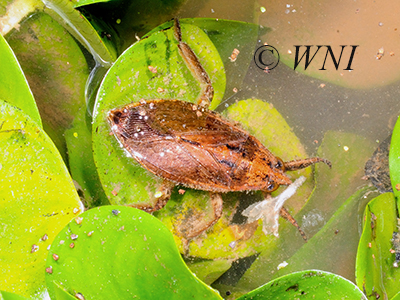| Giant Water Bugs (Belostomatidae) |
The Belostomatidae encompass 3 subfamilies, 9 genera, and ca. 170 species aquatic species found nearly worldwide; most diverse in the Neotropics (110 spp.). They inhabit freshwater ponds, shallow margins of lakes, marshes and slow-flowing streams; few under rocks in riffles. These are the largest Heteroptera (9-120 mm); the majority > 20 mm. The body is dorsoventrally flattened, obovoid to elongate, brownish. The head with a noticeable triangular beak. Their frontal legs are modified into raptorial appendages. A pair of short, posterior respiratory tubes used to obtain air at the water surface. Many species have wings and are capable of flight, while others are flightless. Eggs are deposited on emergent vegetation and guarded by the male (Lethocerinae) or glued onto the male's back and carried until hatching (Abedus and Belostoma; Belostomatinae). Powerful ambush predators feeding on aquatic arthropods, snails, small fish, amphibians, and other small vertebrates. The prey is immobilized and killed with venomous digestive saliva; capable of inflicting a painful bite to humans. Often attracted to lights.
 |
Belostoma dentatum | |
| Unauthorized use of our images is NOT permitted. | ||
| Hotlinking or "pinning" of our images to websites is STRICTLY PROHIBITED. | ||
| Copyright © Michael Patrikeev - All Rights Reserved | ||
| |
||





